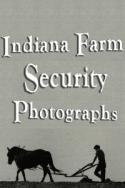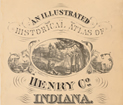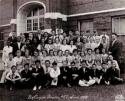Content

Conner Prairie Historic Clothing Collection
Clothing is often a little studied area of American history, but what people wore, how it was made and who made it can offer important insights into a nation's social history. Though clothes do not the man make, they can tell you much about the men, women and children who wore them, and about the society in which they lived. Conner Prairie, an Interactive History Park located in Fishers, Indiana, holds a valuable and substantial collection of historic clothing and accessories. Heretofore, the fragile condition of many of the garments has limited their access to the public. Now, thanks to the partnership of IU Indianapolis University Library and Conner Prairie, these objects may be seen and studied the world over.

Indiana Farm Security Administration Photographs
The U.S. Farm Security Administration took 678 photographs with captions in Indiana from 1935 to 1943. These photos cover the Ohio River flood (1937), resettlement communities of Decatur Homesteads and Wabash and Deshee Farms (1938), and U. S. Army Chaplain School at Fort Ben Harrison (1943). Most of the photos are primarily concerned with rural and traditional agricultural life. There are very few industrial shots and no photos of major industries. The only major city in Indiana photographed was Indianapolis, including photos around Monument Circle, the Greyhound Bus Station, and the Indianapolis Motor Speedway.
Conner Prairie Transferware Collection
Transferware was an 18th-century English innovation in ceramic decoration in which copper-plate engravings were "transferred" to items via a "tissue." No longer was it necessary to laboriously hand-decorate ceramics like tableware, basins or tiles. This early form of mass production was an immediate success and demand grew over the early nineteenth century. Manufacturers like Spode and Wedgewood found eager markets for their deocorative, durable goods, particularly in the United States.
Conner Prairie Traditional Crafts: Preservation and Reproduction
The preservation and continuation of traditional crafts and their skills are important to American culture. The Conner Prairie craft collection is usually limited to museum guests, scholars, and other specialized researchers. By digitizing the collection and making it widely accessible o the internet these historic artifacts and the important story they tell will be available to a mass audience, including teachers and students. This collection consists of Conner Prairie traditional crafts featuring pottery, armsmaking, and blacksmithing.

Conner Prairie Museum Textile Collection
Conner Prairie preserves these textile legacies of the past for present and future generations of families to enjoy. The collection was founded in the 1940s by Ruth and Eli Lilly.
Conner Prairie Historical Almanac Collection
Almanacs, with their calendars, weather forecasts and astronomical information, were often coveted possessions in early American households. Indeed, one 19th-century historian claimed that almanacs and bibles "were the two books most likely to be found in Christian" homes. Though now lost to history one of the very first books thought to be printed in North America was an almanac published in Boston 1639.

Historic Indiana Atlases
The resources in this collection are historical atlases of various Indiana counties including Hamilton, Henry, Madison and Putnam. These books not only provide maps of Hoosier areas dating from 1875 to 1901, but also provide rich historical details of the central Indiana region. Within this collection there are narrative histories, biographical information about Indiana pioneers, detailed illustrations of people and places, statistical tables, and much more. Historians and hobbyists alike should find this collection both information rich and entertaining.

Neighborhood of Saturdays
“The Neighborhood of Saturdays” is a collaborative research project undertaken by the Department of Anthropology at IU Indianapolis along with a number of community-based organizations, including the Concord Neighborhood Center, Etz Chaim Sephardic Congregation, the Southside Picnic Committee and the Babe Denny Neighborhood Organization. Through oral history interviews and archival research, students are reconstructing a portrait of this unique Indianapolis neighborhood, located on the near Southside, that was once home to a range of immigrant groups as well as to significant populations of African-Americans and Appalachians.

Historic Indiana Plat Books
The Plat Books of Indiana Counties are historic guides to the communities of Indiana, showing townships, roads and section numbers. These geographic resources were originally created by Sidwell Studio and W. W. Hixson & Co. between approximately 1925 and 1941. Only approximate dates are available as the publisher neglected to date the books. The original books are owned by and scanned in collaboration with the Indiana State Library through a grant from the Library Fund of Indianapolis Foundation, an affiliate of the Central Indiana Community Foundation.
